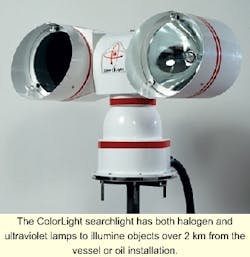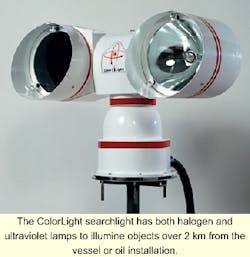SEARCHLIGHT DEVELOPMENT: UV searchlight enhances navigation, rescue, and oil spill detection
The sea is filled with perils for both floating and fixed equipment. Add heavy weather to the mix and all operations become harder. Navigation must be done by instrument because visibility becomes minimal. If a crewman is washed overboard, locating and retrieving him is difficult at best. Heavy weather can also initiate or increase small oil leaks that can affect the environment and endanger the vessel.
Until now these have been intractable problems, but ColorLight has developed a technology to address these issues - a searchlight that uses a special frequency ultraviolet (UV) light, also known as blacklight, to penetrate snow, rain, mist, or fog, and also to detect oil spills.
Special properties
UV light has the ability to cause certain materials to fluoresce. When fluorescent materials are attached to navigation aids, platform supports, rescue boats and capsules, crew clothing, or other floatable objects, the fluorescent materials can be easily seen and located in the water with the use of the UV searchlight.
Most synthetic materials are fluorescent and washed garments are also visible due to the whitening agents in normal detergents.
The searchlight is dual-headed with both halogen and UV searchlamps in one unit. In clear weather, the halogen lamp has a reach of up to 3 km, while the UV searchlamp can project up to 1 km. This provides a wide envelope of protected space around the vessel, when used to avoid hazards. When the UV searchlamp is used alone, the night vision of sailors is preserved.
In heavy weather, the effectiveness of the halogen lamp especially is reduced. The halogen searchlamp's reach is extremely poor in such conditions and is limited to the area immediately around the vessel. The UV searchlamp in contrast can still reach out 0.8-1.0 km, depending on conditions. This enhances safety considerably.
The searchlight is focusable and each searchlamp can be focused independent of the other. Unlike other searchlights, the focusing is done by moving the lighting element rather than using an independent lens system, which would complicate the apparatus. Each searchlamp has a patented special parabolic reflector with myriad angled steps, similar to a Fresnel lens, that guides the light into a wide or narrow beam.
One of the searchlight's key properties is its freedom of movement to direct the light. The searchlight is fitted with dual slipring assemblies that allow the light to be fully rotated 360° in the vertical plane and 360° in the horizontal plane.
There is no need to "unwind" the light, a necessity on some searchlights with internal cable connections. It can be operated by remote control with a simple joystick control that allows rotation in any direction to place the light where it is needed. The searchlight is made of a heavy stainless steel housing for durability and is IP66 approved for heavy seas.
Aside from locating navigational aids, the searchlight is an excellent choice for locating accident victims or floating overboard equipment in the water. The penetration ability of the UV lamp is an order of magnitude improvement over standard searchlights. Its fluorescent properties in heavy weather make it excellent at locating objects hidden by mist or fog.
Oil spill detection
The fluorescent properties also come into play when locating oil leaks from a vessel. Oil has a natural fluorescence under UV light, so it is easy to see the sheen on the water, regardless of the oil's thickness or the type of oil product floating on the water. Thus, the light is excellent for ships and facilities to self-police their vessels and to take action on any leak or spill that occurs before it becomes large or hazardous to people or the environment. Also, it allows the crew to see the varied thickness of a spill and thereby direct a response action more efficiently.
The searchlight is about to be incorporated into the Norwegian navigation system. A new navigational marker system is planned that will place fluorescent paint on buoys and imbed fluorescent materials in markers. Life vests will be required to have fluorescent materials on their exterior as an additional safety measure.
For more information, contact Astrid Hellring-Hansson, ColorLight. Tel: +46 35 382 80, Fax: +46 35 382 79, E-mail: [email protected].

